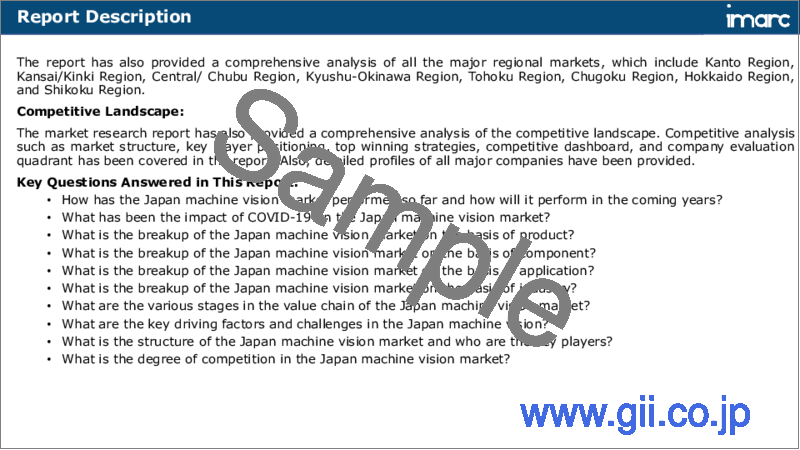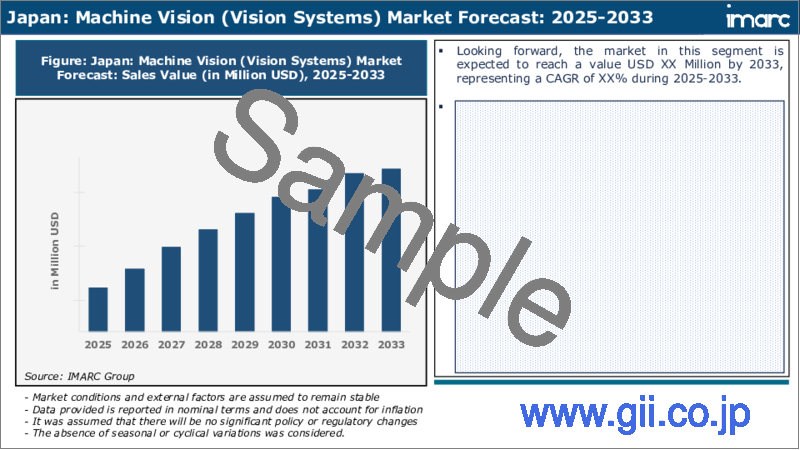|
|
市場調査レポート
商品コード
1609708
日本のマシンビジョン市場レポート:製品、コンポーネント、用途、業界、地域別、2025年~2033年Japan Machine Vision Market Report by Product, Component, Application, Industry, and Region 2025-2033 |
||||||
カスタマイズ可能
|
|||||||
| 日本のマシンビジョン市場レポート:製品、コンポーネント、用途、業界、地域別、2025年~2033年 |
|
出版日: 2024年12月05日
発行: IMARC
ページ情報: 英文 120 Pages
納期: 5~7営業日
|
- 全表示
- 概要
- 目次
日本のマシンビジョン市場の市場規模は2024年に15億8,730万米ドルに達しました。今後、IMARC Groupは、2033年には34億5,580万米ドルに達し、2025~2033年の成長率(CAGR)は9.2%になると予測しています。高解像度化、フレームレートの高速化、感度の向上など、カメラ技術の進歩が続いており、より高度で高性能なマシンビジョンシステムの開発が可能になっていることが市場を牽引しています。
本レポートで扱う主な質問
- 日本のマシンビジョン市場のこれまでの業績と、今後数年間の業績は?
- COVID-19が日本のマシンビジョン市場に与えた影響は?
- 日本のマシンビジョン市場の製品別の内訳は?
- 日本のマシンビジョン市場のコンポーネント別の内訳は?
- 日本のマシンビジョン市場の用途別の内訳は?
- 日本のマシンビジョン市場の業界別の内訳は?
- 日本のマシンビジョン市場のバリューチェーンにはどのような段階がありますか?
- 日本のマシンビジョンの主な促進要因と課題は?
- 日本のマシンビジョン市場の構造と主要プレーヤーは?
- 日本のマシンビジョン市場における競合の程度は?
目次
第1章 序文
第2章 調査範囲と調査手法
- 調査の目的
- ステークホルダー
- データソース
- 市場推定
- 調査手法
第3章 エグゼクティブサマリー
第4章 日本のマシンビジョン市場:イントロダクション
- 概要
- 市場力学
- 業界動向
- 競合情報
第5章 日本のマシンビジョン市場情勢
- 過去および現在の市場動向(2019年~2024年)
- 市場予測(2025-2033)
第6章 日本のマシンビジョン市場:製品別の内訳
- ビジョンシステム
- カメラ
- その他
第7章 日本のマシンビジョン市場:コンポーネント別の内訳
- ハードウェア
- ソフトウェア
第8章 日本のマシンビジョン市場:用途別の内訳
- ポジショニング
- 識別
- 検証
- 測定
- 欠陥検出
- その他
第9章 日本のマシンビジョン市場:業界別の内訳
- エレクトロニクスおよび半導体
- 自動車
- 医療および医薬品
- 食品、包装、印刷
- セキュリティと監視
- インテリジェント交通システム
- その他
第10章 日本のマシンビジョン市場:競合情勢
- 概要
- 市場構造
- 市場プレーヤーのポジショニング
- 主要成功戦略
- 競合ダッシュボード
- 企業評価象限
第11章 主要企業のプロファイル
第12章 日本のマシンビジョン市場:業界分析
- 促進要因・抑制要因・機会
- ポーターのファイブフォース分析
- バリューチェーン分析
第13章 付録
Japan machine vision market size reached USD 1,587.3 Million in 2024. Looking forward, IMARC Group expects the market to reach USD 3,455.8 Million by 2033, exhibiting a growth rate (CAGR) of 9.2% during 2025-2033. The ongoing advancements in camera technologies, such as higher resolutions, faster frame rates, and improved sensitivity, which have enabled the development of more sophisticated and high-performance machine vision systems, are driving the market.
Machine vision is a field of technology that enables computers to visually perceive, process, and understand images or videos in a manner similar to human vision. It involves the use of cameras, specialized hardware, and software algorithms to inspect, analyze, and make decisions based on visual information. By harnessing techniques such as image processing, pattern recognition, and deep learning, machine vision systems can identify and interpret objects, patterns, and scenes within their visual field. Applications of machine vision span across various industries, including manufacturing, healthcare, robotics, and autonomous vehicles. This technology facilitates tasks such as quality control, product inspection, object recognition, and navigation. With advancements in artificial intelligence and computer vision, machine vision continues to evolve, offering enhanced capabilities for automated decision-making and enhancing the efficiency and accuracy of numerous industrial and commercial processes.
Japan Machine Vision Market Trends:
The machine vision market in Japan is driven by several key factors. Firstly, the rising demand for quality inspection and automation across various industries has significantly propelled the adoption of machine vision systems. Additionally, the increasing need for improved productivity and operational efficiency in manufacturing processes has spurred the integration of advanced machine vision technologies. Moreover, the growing trend of Industry 4.0 and the implementation of smart factory concepts have fostered the deployment of machine vision solutions to enhance production processes and ensure higher precision and accuracy. Furthermore, the expanding application of machine vision in diverse sectors such as automotive, electronics, pharmaceuticals, and food and beverages has played a crucial role in driving the market growth. Furthermore, the advancements in artificial intelligence and deep learning algorithms have augmented the capabilities of machine vision systems, enabling them to perform complex tasks with enhanced accuracy and speed. Lastly, the continuous efforts of key market players to develop cost-effective and high-performance machine vision solutions have further stimulated the market expansion, making it more accessible to a wider range of industries.
Japan Machine Vision Market Segmentation:
Product Insights:
- Vision Systems
- Cameras
- Others
Component Insights:
- Hardware
- Software
Application Insights:
- Positioning
- Identification
- Verification
- Measurement
- Flaw Detection
- Others
Industry Insights:
- Electronics and Semiconductor
- Automotive
- Medical and Pharmaceutical
- Food, Packaging and Printing
- Security and Surveillance
- Intelligent Traffic System
- Others
Competitive Landscape:
The market research report has also provided a comprehensive analysis of the competitive landscape. Competitive analysis such as market structure, key player positioning, top winning strategies, competitive dashboard, and company evaluation quadrant has been covered in the report. Also, detailed profiles of all major companies have been provided.
Key Questions Answered in This Report:
- How has the Japan machine vision market performed so far and how will it perform in the coming years?
- What has been the impact of COVID-19 on the Japan machine vision market?
- What is the breakup of the Japan machine vision market on the basis of product?
- What is the breakup of the Japan machine vision market on the basis of component?
- What is the breakup of the Japan machine vision market on the basis of application?
- What is the breakup of the Japan machine vision market on the basis of industry?
- What are the various stages in the value chain of the Japan machine vision market?
- What are the key driving factors and challenges in the Japan machine vision?
- What is the structure of the Japan machine vision market and who are the key players?
- What is the degree of competition in the Japan machine vision market?
Table of Contents
1 Preface
2 Scope and Methodology
- 2.1 Objectives of the Study
- 2.2 Stakeholders
- 2.3 Data Sources
- 2.3.1 Primary Sources
- 2.3.2 Secondary Sources
- 2.4 Market Estimation
- 2.4.1 Bottom-Up Approach
- 2.4.2 Top-Down Approach
- 2.5 Forecasting Methodology
3 Executive Summary
4 Japan Machine Vision Market - Introduction
- 4.1 Overview
- 4.2 Market Dynamics
- 4.3 Industry Trends
- 4.4 Competitive Intelligence
5 Japan Machine Vision Market Landscape
- 5.1 Historical and Current Market Trends (2019-2024)
- 5.2 Market Forecast (2025-2033)
6 Japan Machine Vision Market - Breakup by Product
- 6.1 Vision Systems
- 6.1.1 Overview
- 6.1.2 Historical and Current Market Trends (2019-2024)
- 6.1.3 Market Forecast (2025-2033)
- 6.2 Cameras
- 6.2.1 Overview
- 6.2.2 Historical and Current Market Trends (2019-2024)
- 6.2.3 Market Forecast (2025-2033)
- 6.3 Others
- 6.3.1 Historical and Current Market Trends (2019-2024)
- 6.3.2 Market Forecast (2025-2033)
7 Japan Machine Vision Market - Breakup by Component
- 7.1 Hardware
- 7.1.1 Overview
- 7.1.2 Historical and Current Market Trends (2019-2024)
- 7.1.3 Market Forecast (2025-2033)
- 7.2 Software
- 7.2.1 Overview
- 7.2.2 Historical and Current Market Trends (2019-2024)
- 7.2.3 Market Forecast (2025-2033)
8 Japan Machine Vision Market - Breakup by Application
- 8.1 Positioning
- 8.1.1 Overview
- 8.1.2 Historical and Current Market Trends (2019-2024)
- 8.1.3 Market Forecast (2025-2033)
- 8.2 Identification
- 8.2.1 Overview
- 8.2.2 Historical and Current Market Trends (2019-2024)
- 8.2.3 Market Forecast (2025-2033)
- 8.3 Verification
- 8.3.1 Overview
- 8.3.2 Historical and Current Market Trends (2019-2024)
- 8.3.3 Market Forecast (2025-2033)
- 8.4 Measurement
- 8.4.1 Overview
- 8.4.2 Historical and Current Market Trends (2019-2024)
- 8.4.3 Market Forecast (2025-2033)
- 8.5 Flaw Detection
- 8.5.1 Overview
- 8.5.2 Historical and Current Market Trends (2019-2024)
- 8.5.3 Market Forecast (2025-2033)
- 8.6 Others
- 8.6.1 Historical and Current Market Trends (2019-2024)
- 8.6.2 Market Forecast (2025-2033)
9 Japan Machine Vision Market - Breakup by Industry
- 9.1 Electronics and Semiconductor
- 9.1.1 Overview
- 9.1.2 Historical and Current Market Trends (2019-2024)
- 9.1.3 Market Forecast (2025-2033)
- 9.2 Automotive
- 9.2.1 Overview
- 9.2.2 Historical and Current Market Trends (2019-2024)
- 9.2.3 Market Forecast (2025-2033)
- 9.3 Medical and Pharmaceutical
- 9.3.1 Overview
- 9.3.2 Historical and Current Market Trends (2019-2024)
- 9.3.3 Market Forecast (2025-2033)
- 9.4 Food, Packaging and Printing
- 9.4.1 Overview
- 9.4.2 Historical and Current Market Trends (2019-2024)
- 9.4.3 Market Forecast (2025-2033)
- 9.5 Security and Surveillance
- 9.5.1 Overview
- 9.5.2 Historical and Current Market Trends (2019-2024)
- 9.5.3 Market Forecast (2025-2033)
- 9.6 Intelligent Traffic System
- 9.6.1 Overview
- 9.6.2 Historical and Current Market Trends (2019-2024)
- 9.6.3 Market Forecast (2025-2033)
- 9.7 Others
- 9.7.1 Historical and Current Market Trends (2019-2024)
- 9.7.2 Market Forecast (2025-2033)
10 Japan Machine Vision Market - Competitive Landscape
- 10.1 Overview
- 10.2 Market Structure
- 10.3 Market Player Positioning
- 10.4 Top Winning Strategies
- 10.5 Competitive Dashboard
- 10.6 Company Evaluation Quadrant
11 Profiles of Key Players
- 11.1 Company A
- 11.1.1 Business Overview
- 11.1.2 Product Portfolio
- 11.1.3 Business Strategies
- 11.1.4 SWOT Analysis
- 11.1.5 Major News and Events
- 11.2 Company B
- 11.2.1 Business Overview
- 11.2.2 Product Portfolio
- 11.2.3 Business Strategies
- 11.2.4 SWOT Analysis
- 11.2.5 Major News and Events
- 11.3 Company C
- 11.3.1 Business Overview
- 11.3.2 Product Portfolio
- 11.3.3 Business Strategies
- 11.3.4 SWOT Analysis
- 11.3.5 Major News and Events
- 11.4 Company D
- 11.4.1 Business Overview
- 11.4.2 Product Portfolio
- 11.4.3 Business Strategies
- 11.4.4 SWOT Analysis
- 11.4.5 Major News and Events
- 11.5 Company E
- 11.5.1 Business Overview
- 11.5.2 Product Portfolio
- 11.5.3 Business Strategies
- 11.5.4 SWOT Analysis
- 11.5.5 Major News and Events
12 Japan Machine Vision Market - Industry Analysis
- 12.1 Drivers, Restraints, and Opportunities
- 12.1.1 Overview
- 12.1.2 Drivers
- 12.1.3 Restraints
- 12.1.4 Opportunities
- 12.2 Porters Five Forces Analysis
- 12.2.1 Overview
- 12.2.2 Bargaining Power of Buyers
- 12.2.3 Bargaining Power of Suppliers
- 12.2.4 Degree of Competition
- 12.2.5 Threat of New Entrants
- 12.2.6 Threat of Substitutes
- 12.3 Value Chain Analysis






